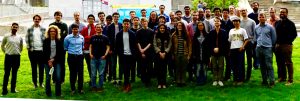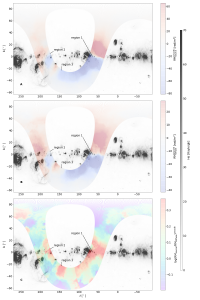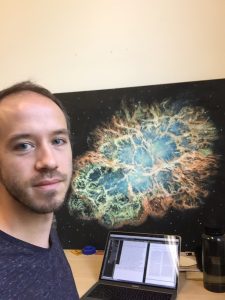Ryan is in his final year as a PhD student, specializing in observational astronomy at radio wavelengths (a.k.a. a radio astronomer!). He’s originally from Quebec where he did his Bachelors in Physics at McGill University, before enrolling in the direct entry PhD stream program at U of T.
What made you interested in Astronomy and Astrophysics?
Like many astronomers, I recall being fascinated by the Universe and its contents at an early age. Its incredible scale, the mystery of its origin and the diverse “zoo” of peculiar objects it contains piqued by curiosity and imagination. It was only in my undergrad that I had the opportunity to engage in research. During this period I also helped form an undergraduate astronomy group that among other things, organized special events and talks accessible to the public.
Can you tell us a little bit about your specific field of research?
Working with my supervisor, Professor Bryan Gaensler, I am generally interested in probing the magnetic field that permeates the Universe. Recently, my time has been split between two projects. One is focused on an automated pipeline for the polarization analysis of FRBs detected by CHIME/FRB and the other is a project looking at the magneto-ionic properties of our Galaxy’s interstellar medium through joint observations of Faraday rotation of extragalactic and Galactic emission (see composite map). While both projects have very different scientific goals, they share a common grounding in the analysis of polarized signal at radio wavelengths. Artificial polarized signal produced by the observing instrument is a common issue with radio dishes. This is particularly the true for CHIME. A fair amount of my research is focused on developing refined methods for characterizing and therefore correcting for this artificial signal.
What’s the most exciting thing about your research?
The most exciting thing about my research is being on the cutting edge of a field of study and having privilege of working with an incredible team of folks with access to data that may transform an entire field! CHIME/FRB is a world class instrument, detecting FRBs at a daily rate of a few per day. The feeling within the collaboration and the FRB field in general is one of being on the edge of a major breakthrough in our understanding of the FRB population.
What do you you hope will be your next step, professionally?
I was recently accepted to a post doctoral position at McGill University where I will continue to work with CHIME/FRB. Specifically, I plan to extend my polarimetric analysis work to CHIME’s commensal pulsar survey. I will also be helping in the development the CHIME/outriggers project, which will use correlated signal from spatially separated CHIME stations for enhanced localization capability. Once fully operational this project will deliver several FRB per day, localized to their host galaxy.

Some members of the CHIME/FRB, Collaboration, including Mckinven, at a meeting in 2019. Source: Ryan Mckinven.

A composite map of the Faraday rotation measures of extragalactic sources and diffuse, Galactic emission and their ratio. Greyscale map shows the Halpha line emission which probes dense, ionized regions of the interstellar medium. Source: Ryan Mckinven


